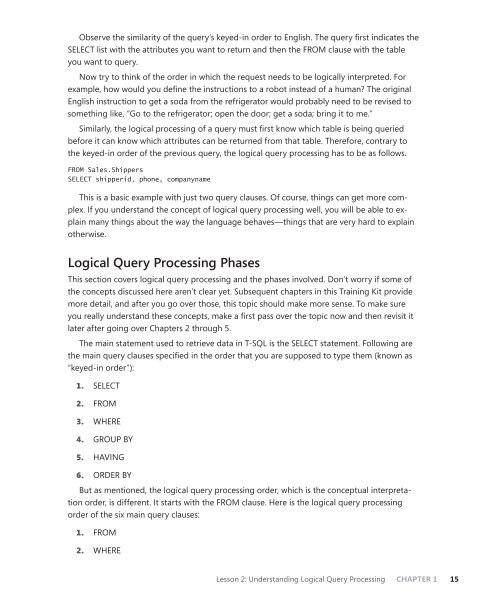Training Kit (Exam 70-461): Querying Microsoft ... - Cdn.oreilly.com
Training Kit (Exam 70-461): Querying Microsoft ... - Cdn.oreilly.com
Training Kit (Exam 70-461): Querying Microsoft ... - Cdn.oreilly.com
Create successful ePaper yourself
Turn your PDF publications into a flip-book with our unique Google optimized e-Paper software.
Observe the similarity of the query’s keyed-in order to English. The query first indicates the<br />
SELECT list with the attributes you want to return and then the FROM clause with the table<br />
you want to query.<br />
Now try to think of the order in which the request needs to be logically interpreted. For<br />
example, how would you define the instructions to a robot instead of a human? The original<br />
English instruction to get a soda from the refrigerator would probably need to be revised to<br />
something like, “Go to the refrigerator; open the door; get a soda; bring it to me.”<br />
Similarly, the logical processing of a query must first know which table is being queried<br />
before it can know which attributes can be returned from that table. Therefore, contrary to<br />
the keyed-in order of the previous query, the logical query processing has to be as follows.<br />
FROM Sales.Shippers<br />
SELECT shipperid, phone, <strong>com</strong>panyname<br />
This is a basic example with just two query clauses. Of course, things can get more <strong>com</strong>plex.<br />
If you understand the concept of logical query processing well, you will be able to explain<br />
many things about the way the language behaves—things that are very hard to explain<br />
otherwise.<br />
Logical Query processing phases<br />
This section covers logical query processing and the phases involved. Don’t worry if some of<br />
the concepts discussed here aren’t clear yet. Subsequent chapters in this <strong>Training</strong> <strong>Kit</strong> provide<br />
more detail, and after you go over those, this topic should make more sense. To make sure<br />
you really understand these concepts, make a first pass over the topic now and then revisit it<br />
later after going over Chapters 2 through 5.<br />
The main statement used to retrieve data in T-SQL is the SELECT statement. Following are<br />
the main query clauses specified in the order that you are supposed to type them (known as<br />
“keyed-in order”):<br />
1. SELECT<br />
2. FROM<br />
3. WHERE<br />
4. GROUP BY<br />
5. HAVING<br />
6. ORDER BY<br />
But as mentioned, the logical query processing order, which is the conceptual interpretation<br />
order, is different. It starts with the FROM clause. Here is the logical query processing<br />
order of the six main query clauses:<br />
1. FROM<br />
2. WHERE<br />
Lesson 2: Understanding Logical Query Processing chapter 1 15
















